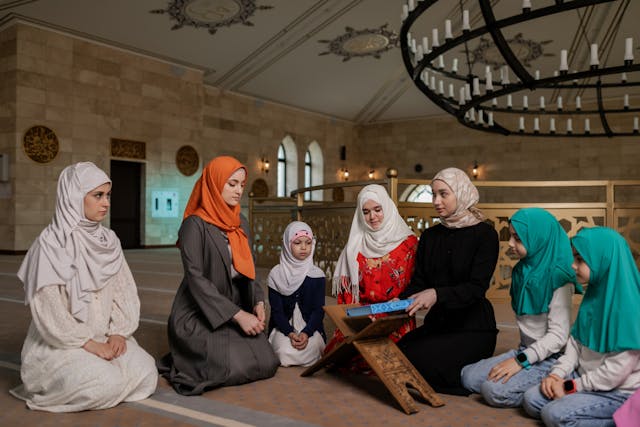Islamic studies for kids is essential in nurturing their spiritual and moral development. Teaching children about Islam from an early age helps them develop a strong connection with their faith, understand moral values, and practice Islamic teachings in their daily lives. This guide explores the importance of Islamic studies, effective teaching methods, and engaging activities to make learning Islam enjoyable for kids.
Importance of Islamic Studies for Kids
1. Building a Strong Faith Foundation
Islamic studies provide children with the fundamental beliefs of Islam, including the Oneness of Allah (Tawheed), prophethood, and the afterlife. Children learn these concepts early and develop a deep sense of faith and trust in Allah.
2. Instilling Moral and Ethical Values
Islam teaches virtues such as honesty, kindness, patience, and humility. These values help shape children’s character and encourage them to interact positively with others.
3. Strengthening the Bond with the Quran
The Quran is the primary source of guidance for Muslims. Encouraging children to read, memorize, and understand the Quran from an early age helps them develop a love for Allah’s words and apply its teachings in their daily lives.
4. Teaching the Significance of Salah (Prayer)
Salah is one of the five pillars of Islam. Instilling the habit of performing Salah in children ensures they remain connected with their Creator throughout their lives.
5. Encouraging a Love for Prophet Muhammad (PBUH)
Learning about the life and teachings of Prophet Muhammad (PBUH) helps children appreciate his exemplary character and motivates them to follow his Sunnah.
Effective Teaching Methods for Islamic Studies
1. Using Storytelling
Children love stories. Teaching Islamic lessons through stories from the Quran and Hadith makes learning engaging. Stories of prophets, Sahaba (companions), and righteous people inspire children to adopt Islamic values.
2. Interactive and Fun Learning
Incorporating activities such as puzzles, coloring books, and Islamic games helps make learning enjoyable. Interactive learning enhances children’s retention and understanding of Islamic teachings.
3. Visual Aids and Multimedia
Using visual aids like posters, animations, and Islamic cartoons helps explain concepts effectively. Kids understand better when they see and hear information through engaging media.
4. Practical Demonstrations
Instead of merely instructing children to perform Wudu (ablution) or Salah, demonstrating it practically ensures better learning. Parents and teachers should perform these actions with kids to reinforce their understanding.
5. Encouraging Questions and Discussions
Children are naturally curious. Encouraging them to ask questions about Islam and discussing their doubts with patience helps build a strong understanding of their faith.
6. Using Rewards and Encouragement
Positive reinforcement motivates kids to learn and practice Islam. Small rewards like stickers, certificates, or verbal praise encourage them to follow Islamic teachings consistently.
Essential Topics in Islamic Studies for Kids
1. Belief in Allah (Tawheed)
Teaching children about the Oneness of Allah and His attributes helps them develop a strong belief in Him.
2. The Five Pillars of Islam
Understanding and practicing the five pillars – Shahadah (faith), Salah (prayer), Zakah (charity), Sawm (fasting), and Hajj (pilgrimage) – is crucial for every Muslim child.
3. Stories of the Prophets
Learning about Prophet Adam, Nuh, Ibrahim, Musa, Isa, and Muhammad (peace be upon them all) helps children understand the history of Islam and draw valuable moral lessons.
4. Islamic Manners and Etiquette
Teaching children good manners, including how to greet others, respect elders, and express gratitude, aligns with Islamic teachings and strengthens their character.
5. Learning the Quran and Duas
Encouraging children to memorize short Surahs, Ayahs, and daily Duas ensures they incorporate Islamic prayers into their daily routines.
6. Understanding Halal and Haram
Teaching kids about permissible (Halal) and forbidden (Haram) actions helps them make ethical decisions from an early age.
Engaging Activities for Teaching Islamic Studies
1. Quran Recitation Competitions
Organizing Quran recitation competitions encourages kids to memorize and recite the Quran with proper Tajweed (pronunciation).
2. Islamic Arts and Crafts
Activities like making Islamic calligraphy, creating Ramadan calendars, or designing mosque models make learning interactive and fun.
3. Role-Playing Islamic Stories
Reenacting stories of prophets and Islamic historical events helps children memorably grasp lessons.
4. Islamic Board Games and Quizzes
Islamic-themed board games and quizzes test children’s knowledge while making learning enjoyable.
5. Practicing Charity
Encouraging children to donate toys, clothes, or money to those in need fosters empathy and aligns with the concept of Zakah and Sadaqah (charity).
6. Celebrating Islamic Events
Teaching children about Ramadan, Eid-ul-Fitr, and Eid-ul-Adha through special activities like fasting challenges, Eid crafts, and storytelling enhances their connection to Islamic traditions.
Role of Parents in Teaching Islamic Studies
1. Leading by Example
Children learn best by observing their parents. Practicing Islam consistently at home reinforces Islamic values in children.
2. Creating an Islamic Environment
Having an Islamic-friendly home with Quranic recitations, Islamic books, and reminders of Islamic teachings fosters a spiritual atmosphere.
3. Encouraging Islamic Discussions
Regular conversations about Islamic topics help children develop a strong understanding of their faith.
4. Praying Together
Performing Salah as a family strengthens children’s bond with prayer and instills consistency in their practice.
5. Monitoring Islamic Content
Ensuring children consume authentic Islamic media and books prevents misconceptions and fosters correct Islamic knowledge.
Conclusion
Teaching Islamic studies to kids is an invaluable investment in their future. By using engaging and interactive methods, parents and educators can make learning Islam a delightful experience. Instilling faith, morals, and the love of the Quran from an early age helps children grow into responsible and righteous Muslims. With dedication and creativity, we can inspire the next generation to embrace their Islamic identity with pride and sincerity.



